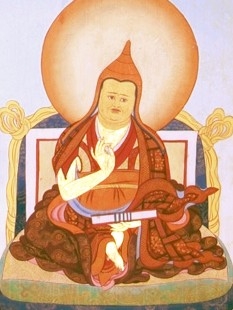Mipham Rinpoche: Difference between revisions
| Line 17: | Line 17: | ||
==Writings== | ==Writings== | ||
*[[Khenjuk]] | *[[Khenjuk]] | ||
*[[Sword of Wisdom for Thoroughly Ascertaining Reality]] | *[[Sword of Wisdom for Thoroughly Ascertaining Reality]] | ||
*[[The Ketaka Gem]] | *[[The Ketaka Gem]] | ||
*[[Wangdü]] | *[[Wangdü]] | ||
*[[Wheel of Analytical Meditation]] | |||
*[[White Lotus]]: An Explanation of the Seven-Line Prayer to Guru Padmasambhava | |||
*[[Words to Delight My Teacher Manjughosha]] | *[[Words to Delight My Teacher Manjughosha]] | ||
==Internal Links== | ==Internal Links== | ||
Revision as of 07:59, 28 July 2008

Mipham Rinpoche (1846-1912) - a great Nyingma master and writer of the last century, student of Jamgön Kongtrul, Jamyang Khyentsé Wangpo and Patrul Rinpoche. Blessed by Manjushri, he became one of the greatest scholars of his time. His collected works fill more than thirty volumes. His chief disciple was Shechen Gyaltsab Pema Namgyal.
Biography
Mipham Rinpoche was born in the region of Derge in eastern Tibet. At the age of fifteen he undertook eighteen months of intensive retreat on Manjushri. He later confided to some of his students that from then on he had always been able to understand any text he read. Patrul Rinpoche taught him on the famous ninth chapter of the Bodhicharyavatara, ‘Wisdom’, and himself confirmed that after just five days’ teaching, Mipham Rinpoche had completely mastered both the words and meaning of the text. Mipham Rinpoche also received and mastered innumerable teachings and transmissions from Jamyang Khyentsé Wangpo and Jamgön Kongtrul, as well as from masters of all traditions throughout Tibet. He always took to heart Je Tsongkhapa’s famous advice that the teachings should be regarded first and foremost as practical guidance for life rather than merely as intellectual speculations. Mipham Rinpoche had an enormous impact in re-awakening a deep reverence and interest in the Nyingma and Dzogchen teachings. His contribution to the Rimé movement is inestimable.
His principal students were the great Shechen Gyaltsap Rinpoche, and his attendant and secretary, Lama Ösel. His other close students included many of the greatest lamas of the time: Katok Situ Chökyi Gyatso; Shechen Rabjam Rinpoche; Tertön Sogyal; the third Dodrupchen, Jikmé Tenpé Nyima; the fifth Dzogchen Rinpoche; Adzom Drukpa and many others. He also blessed and gave transmissions to the young Dilgo Khyentsé Rinpoche, to whom he gave the name ‘Mangala Shri Bhuti’.
Mipham was a prolific writer; three hundred and twenty-two of his Dharma works have come down to us. Apart from these, he composed more than thirty-five books on a range of subjects including medicine; poetry (particularly the Gesar epics); logic; cosmology; astrology and divination; alchemy; painting and sculpture; and engineering. For example, there is an oral tradition that at one time he designed and built a machine that flew; but soon dismantled it again, saying that such things were just distractions.
Shortly before he passed away, he told his attendant Lama Ösel:
- Nowadays, if you speak the truth, there is nobody to listen; if you speak lies everyone thinks it is true. I have never said this before: I am not an ordinary person; I am a bodhisattva who has taken rebirth through aspiration. The suffering experienced in this body is just the residue of karma; but from now on I will never again have to experience karmic obscuration. … Now, in this final age, the barbarians beyond the frontier are close to undermining the teaching. [So] there is no point whatsoever in my taking rebirth here…I have no reason to take birth in impure realms ever again.
Writings
- Khenjuk
- Sword of Wisdom for Thoroughly Ascertaining Reality
- The Ketaka Gem
- Wangdü
- Wheel of Analytical Meditation
- White Lotus: An Explanation of the Seven-Line Prayer to Guru Padmasambhava
- Words to Delight My Teacher Manjughosha